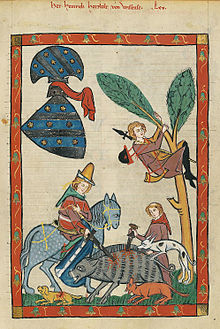Heinrich Hetzbold von Weißensee

Heinrich Hetzbold von Weißensee was a minstrel in the first half of the 14th century.
Life
Heinrich Hetzbold von Weißensee, also known as Hezbold, was a member of the lower nobility in the service of the Landgraves of Thuringia . He was her Burgmann and Vogt to Weißensee and the nearby Schönstedt . He chartered there between 1310 and 1345. You can imagine him as a singer in front of a small court audience at the Landgrave's Runneburg zu Weißensee.
plant
In his miniature, the first additional painter of the Great Heidelberg Song Manuscript addressed the name of the minstrel: The name "Hetzbold" means "courageous hunter", and as such he portrays him hunted for wild boar.
In his eight, consistently three-verse songs, handed down in the Codex Manesse, Hetzbold fulfills the traditional pattern of late minstrels. He praises the beauty of the revered mistress, hopes that she will give him a smile, and dreams of being kissed by her red mouth. All songs, with references to Hetzbold's Thuringian predecessors Heinrich von Morungen and Kristan von Luppin , are pervaded by lamentations of love. However, these remain unanswered, and so the mistress' moral integrity is clearly emphasized. However, Hetzbold adds his own to this pattern. On the one hand, he loosens the plaintive tone with popular expressions when he calls the mistress “mîn zuckerkrûtken”, his sweet medicinal herb, and makes her mouth look as if he were saying “five”. On the other hand, by apostrophizing the mistress as his "leitvertrîp", he brings an indirect threat into play with the unspoken but obvious association "zîtvertrîp", which other mouths still disdained by him could give him. Hetzbold emphasizes that his songs are the mirror for the beauty of the mistress; if he fell silent, it should fade. He is the knight who holds out his clasped hands to his mistress so that she can clasp them with hers on the mutual feudal contract: women's praise for love (in reality probably material) wages. It is as if with his songs Hetzbold wanted to once again set a monument to the minne service at the end of the Middle Ages. And when, at the end of the first song, he calls himself, unusually, by name, and closes the last song with the mistress hiding name, "the beautiful shine", he brings the knight and the songs as that the mistress entangling tape reveals the love affair to the point.
expenditure
All of Hetzbold's songs in:
- Codex Manesse. The Great Heidelberg Song Manuscript, sheet 228 a. 229; Codex Palatinus Germanicus 848 of the Heidelberg University Library. Full facsimile in 12 partial deliveries, with interim texts by Ingo F. Walter. Frankfurt a. M. 1975-1988
- "The Great Heidelberg Song Manuscript". Edited by Fridrich Pfaff in a true print of the text . Second, improved and supplemented edition edited by Hellmut Salowski. Heidelberg 1984
- Carl von Kraus (ed.): German song writers of the 13th century, Volume I: Text, Volume II: Commentary, provided by Hugo Kuhn. Second edition Tübingen 1978
- Gerhard Tänzer (ed.): "Frouwe, frouwe, frouwe mîn!" Thuringian Minnelieder. Text, transmission, comment. Bucha near Jena 2005
literature
- Ingo F. Walther (Ed.): Codex Manesse. The miniatures of the Great Heidelberg Song Manuscript . Frankfurt a. M. 1988
- Volker Mertens: Hetzbold, Heinrich, von Weißensee . In: Kurt Ruh et al. (Ed.): The German literature of the Middle Ages. Author Lexicon . 2nd Edition. 3rd volume. Berlin 1981, column 1204 f.
- Marianne Kreutzer: Hetzbold, Heinrich, von Weißensee. In: New German Biography (NDB). Volume 9, Duncker & Humblot, Berlin 1972, ISBN 3-428-00190-7 , p. 34 f. ( Digitized version ).
- Karl Bartsch : Hetzbold von Weißensee, Heinrich (1st article) . In: Allgemeine Deutsche Biographie (ADB). Volume 12, Duncker & Humblot, Leipzig 1880, p. 322.
- Richard Moritz Meyer: Hetzbold von Weißensee, Heinrich (2nd article) . In: Allgemeine Deutsche Biographie (ADB). Volume 41, Duncker & Humblot, Leipzig 1896, p. 609 f.
- Friedrich Heinrich von der Hagen : Minnesinger: German song poet of the twelfth, thirteenth and fourteenth centuries . 4th edition. Barth, 1838, 74. Mr. Heinrich Hetzbold von Weißensee, p. 316-318 ( Googlebook ).
Web links
| personal data | |
|---|---|
| SURNAME | Heinrich Hetzbold von Weißensee |
| ALTERNATIVE NAMES | Hezbold |
| BRIEF DESCRIPTION | Thuringian minstrel |
| DATE OF BIRTH | before 1310 |
| DATE OF DEATH | after 1345 |